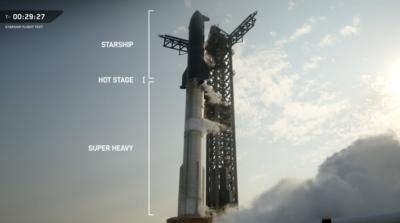Thu, May 29, 2025
First Reflight Of Super Heavy Booster, Stage Separation Successful
The ninth test flight of SpaceX’s Starship lifted off from Starbase in South Texas at 6:36 p.m. CDT on May 27, and experienced a mixed bag of results with the first reflight of the Super Heavy booster and the upper stage Ship getting farther than it did the past two test flights.

The Starship team will have a lot of data, both good and bad, to chew on for planning the tenth flight. The Super Heavy booster launched and lifted the Starship upper stage to a full-duration ascent with all 33 of its Raptor engines performing normally.
The upper stage separated in a nominal hot-stage maneuver and Super Heavy performed a ‘deterministic’ flip and boostback burn. It then descended at a much more structurally stressful higher angle of attack and slower speed. This was designed to test its performance and gather useful data to improve future performance of the Super Heavy.
It was not scheduled to return for a catch by the chopsticks mechanism or land on a droneship and made it almost to splashdown when its flight ended in a rapid unscheduled disassembly.
All six of the upper stage Raptor engines lit and performed a nominal full-duration ascent burn and Starship did make it successfully to the engine cutoff point. During the orbital coasting phase, Ship was scheduled to deploy a payload of simulated Starlink satellites, however the payload bay door failed to open so a successful deployment was not achieved.

Subsequently, leaks in the main tank caused a loss of attitude control and Ship eventually began to spin and tumble during the coast and reentry phases. The loss of attitude control led to the decision to skip the planned Raptor relight and initiated an automated safing procedure to vent remaining fuel and place the Ship in the safest condition for reentry.
During Ship’s reentry phase, contact was lost at about 46 minutes into the flight and all debris was expected to fall within the planned hazard area in the Indian Ocean.
Elon Musk, Founder of SpaceX said in a post-launch statement on X, “Starship made it to the scheduled ship engine cutoff, so big improvement over last flight! Also, no significant loss of heat shield tiles during ascent. Leaks caused loss of main tank pressure during the coast and re-entry phase. Lot of good data to review.”
More News
LinxUs System Adds Capabilities for Data-Driven Operators Textron Aviation announced another option for operators processing their post-flight data, adding interoperability with GE>[...]
Aero Linx: The de Havilland Moth Club Ltd The de Havilland Moth Club evolved from a belief that an association of owners and operators of Moth aeroplanes should be formed to create>[...]
(Pilot) Inadvertently Applied Excessive Braking Action, And The Airplane Nosed Over Analysis: The pilot reported that, while landing at a remote, rough and uneven airstrip in a tai>[...]
“MCADT is committed to rapidly integrating armed first-person view drones into the FMF, enhancing small-unit lethality and providing organic capabilities that warfighters cur>[...]
From 2017 (YouTube Edition): Major Engine Supplier Joins Forces With Small Aircraft Manufacturer… GE recently made an agreement with Venom Aircraft to supply engines for the>[...]
 Citation Operators Get Another Flight Data Connection for QA
Citation Operators Get Another Flight Data Connection for QA ANN's Daily Aero-Linx (06.01.25)
ANN's Daily Aero-Linx (06.01.25) NTSB Final Report: Bellanca 8GCBC
NTSB Final Report: Bellanca 8GCBC Aero-News: Quote of the Day (06.01.25)
Aero-News: Quote of the Day (06.01.25) Classic Aero-TV: High-Speed Match-up - Venom and GE Rebirth A Legend
Classic Aero-TV: High-Speed Match-up - Venom and GE Rebirth A Legend




